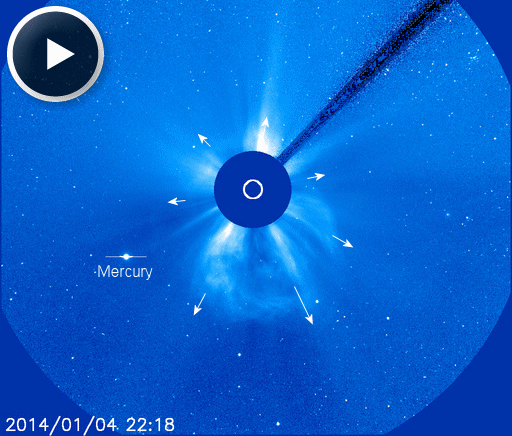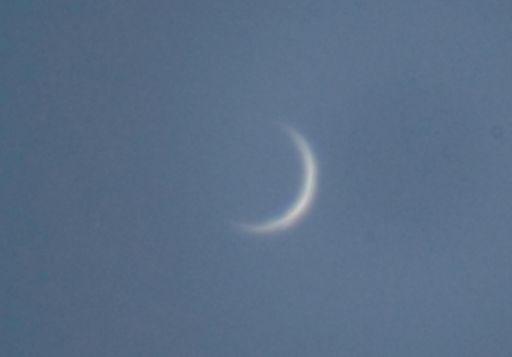When is the best time to see auroras? Where is the best place to go? And how do you photograph them? These questions and more are answered in a new book, Northern Lights - a Guide, by Pal Brekke & Fredrik Broms. | | | FLARES LIKELY TODAY: Giant sunspot AR1944 has developed a 'beta-gamma-delta' magnetic field that harbors energy for potent Earth-directed eruptions. NOAA forecasters estimate a 75% chance of M-class flares and a 30% chance of X-flares on Jan. 5th. Solar flare alerts: text, voice. CME, POSSIBLY INCOMING: A coronal mass ejection (CME) might be heading for Earth. The cloud blasted away from the sun during the late hours of Jan 4th following a long-duration M4-class solar flare from big sunspot AR1944. SOHO (the Solar and Heliospheric Observatory) recorded the explosion: 
The assymetric CME could deliver a glancing blow to Earth's magnetic field on January 7th, possibly sparking G1-class geomagnetic storms. NOAA analysts are still processing the CME imagery for a more precise forecast. Watch the movie again. There might be two CMEs in there. After the first cloud from sunspot AR1944 emerged, a second cloud was propelled off the sun's western limb by departing sunspot AR1936. The mixture of CMEs complicates analysis of this event. Stay tuned for updates. Geomagnetic storm alerts: text, voice. Realtime Space Weather Photo Gallery VENUS, THE CRESCENT PLANET: Venus is turning its night side toward Earth as it approaches inferior solar conjunction on Jan. 11th. Less than 2% of Venus's sunlit hemisphere is now facing us, which means the planet looks like a razor-thin crescent. If you have a GOTO telescope, command it to slew to Venus. It's visible even in broad daylight: 
Amateur astronomer Steven Bellavia of New York took the picture at noon on Jan. 4th using a Celestron C5 telescope. "This is the finest crescent Venus I have ever been able to photograph," he says. Observers who wish to try this for themselves can find Bellavia's photo details here. Be careful, though, because Venus is only 10o from the blinding sun. Realtime Venus Photo Gallery
Realtime Aurora Photo Gallery
Realtime Comet Photo Gallery
Every night, a network of NASA all-sky cameras scans the skies above the United States for meteoritic fireballs. Automated software maintained by NASA's Meteoroid Environment Office calculates their orbits, velocity, penetration depth in Earth's atmosphere and many other characteristics. Daily results are presented here on Spaceweather.com. On Jan. 4, 2014, the network reported 35 fireballs.
(19 sporadics, 14 Quadrantids, 1 lambda Bootid, 1 December Leonis Minorid) 
In this diagram of the inner solar system, all of the fireball orbits intersect at a single point--Earth. The orbits are color-coded by velocity, from slow (red) to fast (blue). [Larger image] [movies] On Jan. 3, 2014, the network reported 27 fireballs.
(14 sporadics, 13 Quadrantids) 
In this diagram of the inner solar system, all of the fireball orbits intersect at a single point--Earth. The orbits are color-coded by velocity, from slow (red) to fast (blue). [Larger image] [movies] Potentially Hazardous Asteroids ( PHAs) are space rocks larger than approximately 100m that can come closer to Earth than 0.05 AU. None of the known PHAs is on a collision course with our planet, although astronomers are finding new ones all the time. On January 5, 2014 there were potentially hazardous asteroids. Notes: LD means "Lunar Distance." 1 LD = 384,401 km, the distance between Earth and the Moon. 1 LD also equals 0.00256 AU. MAG is the visual magnitude of the asteroid on the date of closest approach. | | The official U.S. government space weather bureau | | | The first place to look for information about sundogs, pillars, rainbows and related phenomena. | | | Researchers call it a "Hubble for the sun." SDO is the most advanced solar observatory ever. | | | 3D views of the sun from NASA's Solar and Terrestrial Relations Observatory | | | Realtime and archival images of the Sun from SOHO. | | | from the NOAA Space Environment Center | | | the underlying science of space weather | | 
